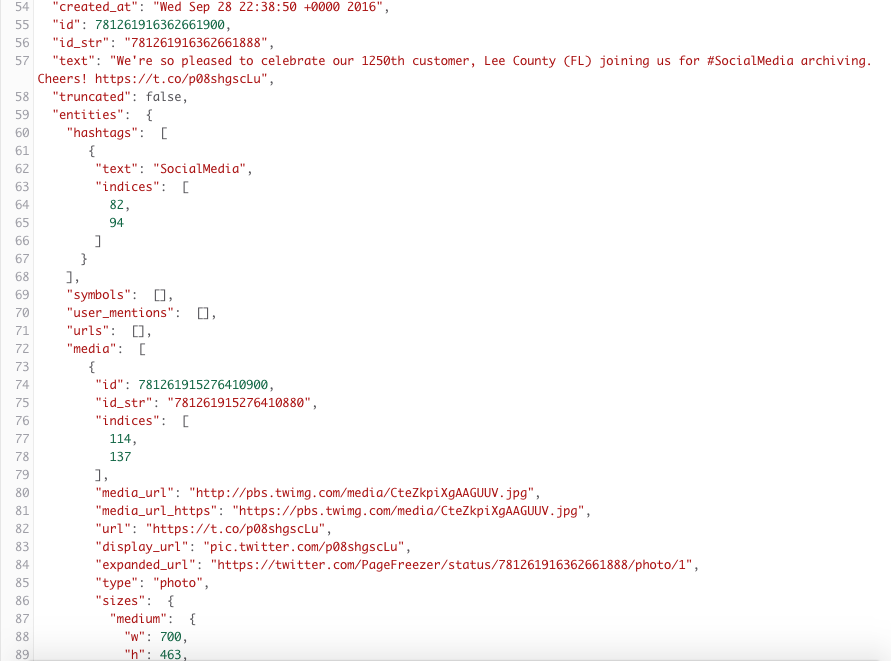For legal and recordkeeping compliance, understanding and capturing metadata of your organization's online presence is essential.
Metadata, in the context of websites and social media activity, is a data that describes and gives information about other data. Simply put, it is trail of information that we leave behind when browsing, clicking, and sharing information online. This is particularly true of metadata on social media platforms and websites, where high frequency, personal and professional interactions can generate a huge amount of associated incidental data.
How Does Metadata Relate To eDiscovery?
When it comes to digital evidence, metadata plays a key role. It provides valuable information about a piece of content, beyond the elements of the post, email, webpage or message that is visible to the naked eye.
It’s this capacity to give the examiner a deeper contextual understanding of the content being investigated that makes metadata so valuable to eDiscovery professionals – it helps paint a complete picture.
Which Types of Metadata Are Relevant to Digital Evidence?
In the world of digital evidence, there are 4 primary types of important metadata:
- Device Metadata (who and how it was collected)
i.e Browser, operating system, IP address, user, session ID, network info - Web Server/API Endpoint Metadata (where and when it was collected)
i.e URL, HTTP headers, type, timestamps of request and response - Account Metadata (who is the owner)
i.e Account owner, bio, description, location - Message Metadata (what was said when)
i.e Author, message type, post timestamps, versions, links, location, privacy settings, likes, comments, friends
Example Of Social Media Metadata
In this example, we will show you what social media metadata looks like and how it compares to what the user sees on the social media platform.
First, here's what you would see if you were viewing this social media post on the X (formerly Twitter) platform:
On the back-end there exists a wealth of useful metadata that can be captured, like location, ID, expanded URL destinations and image sizes. Here's what the social media post's metadata looks like:

Social Media Metadata & Litigation
That metadata you generate can give tremendous insight into who you are, where you live, and where else you spend your time online. As a result, metadata is very valuable and can have numerous applications. On the (arguably) less sinister end, metadata can be captured and used to retarget you with specifically tailored ads. In much more serious instances, it can aid in cases of insurance fraud, IP infringement, divorce and family matters.
Metadata can help to provide essential and contextual information about the "when and where" of actions related to a legal case, making it key to proving authenticity and integrity in court.
Capturing all of your website and social media evidence's metadata in evidentiary quality is important if you want to present it in court, but it's not all you need to ensure admissibility of the evidence. Making sure all the content is then digitally signed (256-bit) and time-stamped will help you satisfy legal and chain of custody requirements for digital evidence.
Why Is Capturing Social Media & Website Metadata So Important For Organizations?
Social media is a valuable communication and promotion channel for modern business. A social media presence is all but essential today, but depending on your industry certain compliance measures will apply too your organization's social media presence.
In order to be considered reliable evidence, admissible in a court of law, your social media records need to be recorded in a manner that gives all associated information, including metadata. This serves to authenticate the evidence, presenting it in context, as well as highlighting any amendments, edits or deletions that may have occurred.
In the more highly regulated industries like financial services and healthcare, you’ll be required to keep comprehensive archives of all social media activity — and metadata is an essential element of this recordkeeping. Your organization's social media accounts (and in some cases personal accounts associated with your business), are considered business records. That means you need to maintain a proper and identifiable record of everything published by your organization.
How To Capture Your Organization's Social Media & Website Metadata
Luckily, there are many tools that can help you capture metadata, but exact methods of metadata capture will depend on the medium.
For example, automated archiving solutions can crawl your website and social media accounts and take frequent snapshots of all your webpages and social media account activity, including posts, comments, emojis, reactions, and replies.
If you're trying to meet recordkeeping requirements of your industry, choosing a fully automated solution will ensure total coverage with no margin for human error. The user should be able to define the crawl intervals and capture all content and all associated metadata.
For the most accurate and realtime data capture, your solution should use an API integration (like Facebook’s Graph API, for example.) This method offers the most comprehensive capture of social media content, ensuring that all data is archived retroactively, right back to the origin of the account. This means that all interactions with posts, edits and deletions can be accessed and viewed at any time, even if you've just started the archiving process.
A suitable solution should also allow you to export the evidence and associated metadata in evidentiary quality, so it is usable in legal and compliance applications. To ensure the evidence has not been tamped with, we also recommend a solution that can sign records with a SHA-256 digital signature.
Conclusion: Start Archiving Your Social Media & Website Metadata ASAP
Metadata serves as the invisible thread that connects the dots in digital evidence, offering crucial insights and context that are vital for legal and compliance purposes. By capturing and preserving metadata with the right tools, organizations can ensure the integrity and admissibility of their social media and website records, safeguarding them for potential litigation and regulatory scrutiny.
As online activity keeps growing, managing your organization's metadata properly becomes more important than ever.









